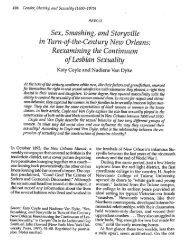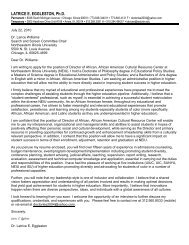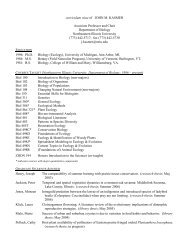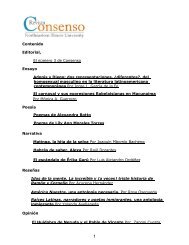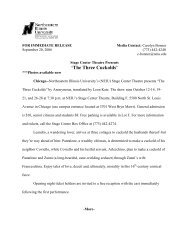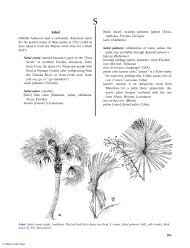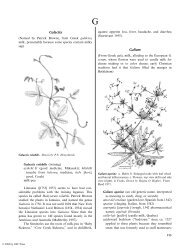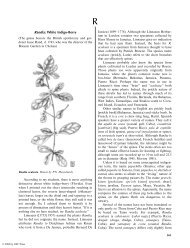Herba Cana - Northeastern Illinois University
Herba Cana - Northeastern Illinois University
Herba Cana - Northeastern Illinois University
You also want an ePaper? Increase the reach of your titles
YUMPU automatically turns print PDFs into web optimized ePapers that Google loves.
© 2004 by CRC Press<br />
The Ethnobotany 529<br />
Several indigenous names are descriptive or simple<br />
terms. Among those are caajandiva [caajandivas] (caa,<br />
plant, jandiva, from ñandi’á, catfish, Tupí, Brazil),<br />
caaponga [caapononga, caponga] (caa, plant, ponga,<br />
climber, Tupí, Brazil), chabak [chab-ak, chabac, chapak]<br />
(chab, bad odor, ak, vine, Maya, Yucatán),<br />
guacochile (if Náhuatl, maybe from uactoc, mature,<br />
chilli, chile, El Salvador), guaicuru (maybe Taino), and<br />
turicua [tiricua, jiricua] (Guanajuato, Tamaulipas).<br />
The Huastec call it hurika, and some people have<br />
spelled that eureka (San Luis Potosí). The second<br />
spelling has no linguistic relation to ‘‘eureka’’ in<br />
English.<br />
Leaves and roots when applied to the skin produce<br />
almost instant reddening and in a short time blisters.<br />
An external decoction is used to treat erysipelas, felon,<br />
itch, mange, warts, external ulcers, leprosy, and similar<br />
problems (Bye 1986). Root juices have also been used<br />
to cauterize ulcers in horses (Mors et al. 2001). The<br />
same parts are poisonous if taken internally (Tokarnia<br />
and Dobereiner 1982, Medeiros et al. 2001, Mors et al.<br />
2001). Plumbago europea has similar properties and is<br />
used as an emetic; when chewed, the plant increases<br />
saliva flow. Roots are used from both species to relieve<br />
pains in ears and teeth, for swollen joints, and as a<br />
purgative (Mors et al. 2001). Beggars have applied the<br />
leaves to raise sores on their body to arouse pity<br />
(Standley 1920 /1926). Leaves and roots are macerated<br />
in alcohol and applied to the skin to treat rheumatism<br />
(Pittier 1926, Petersen 1974, Liogier 1974).<br />
Roots and leaves contain plumbagin (Harborne<br />
1967), a naphthoquinone derivative characteristic of<br />
most species in the genus (Mors et al. 2001). There are<br />
related compounds in P. scandens and other species<br />
(Sankaram et al. 1979, Bhattacharyya and Carvalho<br />
1986, Dinda and Chel 1992, Dinda 1994, Gupta et al.<br />
1999). Plumbagin is active against several fungi and<br />
bacteria (Gonçalves de Lima et al. 1968, Vijver and<br />
Lotter 1971, Bambode and Shukla 1974, Durga et al.<br />
1990, Ahmad et al. 1998, Ali-Shtayeh and Abu<br />
Ghdeib 1999, Beg and Ahmad 2000). In addition,<br />
plumbagin and related compounds have shown promise<br />
in cancer treatment, for inhibiting inflammation,<br />
in controlling cholesterol, and improving cardiotonic<br />
action (Melo et al. 1974, Itoigawa et al. 1991, Sharma<br />
et al. 1991, Oyedapo 1996, Devi et al. 1999).<br />
Several studies show that the chemicals in Plumbago<br />
inhibit feeding by insects (Kubo et al. 1980,<br />
Sharma 1984, Hassanali and Lwande 1989). In spite of<br />
the potpourri of toxins in the plants, one genus of<br />
North American butterfly uses Plumbago for its<br />
larvae. Those animals are butterflies in the genus<br />
Leptotes, but specifically L. cassius (Cassius blue) and<br />
L. marina (marine blue) use Plumbago (Brown 1990,<br />
Minno and Minno 1999). How the larvae of those tiny<br />
blue gems can ingest the scalding compounds with<br />
immunity is unknown. Yet, when they become adults,<br />
they can also sip nectar from the flowers.<br />
Podophyllum<br />
(From Greek pous, podos, a foot, and phyllon, a leaf;<br />
Linnaeus modified the name from Catesby’s Anapodophyllum,<br />
duck foot leaf)<br />
Podophyllum peltatum. From Britton and Brown 1897.<br />
Podophyllum peltatum (shield-shaped)<br />
behen (from Medieval Latin behen, corrupted from<br />
Arabic bahman [behmen], a kind of root; the<br />
word appeared in English in Henry Lyte’s 1578<br />
translation of Dodoens’s Cruydeboek of 1554 as<br />
‘‘Called ... of herboristes at this day Behen, or<br />
Been album’’)<br />
che-sa-ne-pe-sha (it pains the bowels, Osage; also<br />
called shon’-gthin-dse)<br />
citron (fruits resembling Citrus medica, among the<br />
French in 1700, Missouri); citron sauvage (wild<br />
citron, Citrus medica, Quebec)<br />
devil’s-apple; hog apple (Iowa); Indian apple; mugapple<br />
duck’s foot (in use by the 1730s by Catesby); wild<br />
duckfoot<br />
fala imisito (fala, crow, im, its, isito, pumpkin,<br />
Choctaw); fala intanchi (fala, crow,in, its, tanchi,<br />
corn, Choctaw); falaanosi’ (fala, crow,aanosi’,<br />
bed, Chickasaw)<br />
ipecacuana (from ipega’kwai, duck’s penis, or ipekaa-guéne,<br />
creeping plant causing vomiting,<br />
Tupí, Carolinas, Catesby 1731 /1732)





